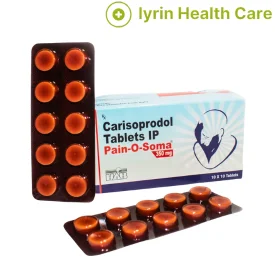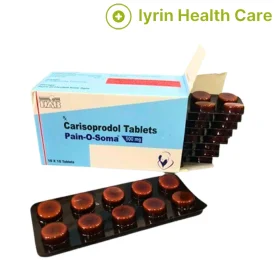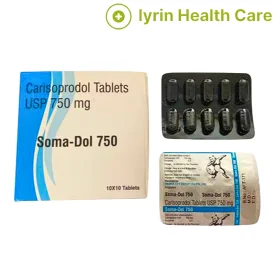Skeletal Muscle Relaxants

Understanding skeletal muscle relaxants is essential, as these medications play a significant role in managing pain and improving mobility. With a variety of conditions that can lead to muscle spasms and discomfort, it is important to be informed about the options available. In this blog, we will cover the different types of skeletal muscle relaxants, their indications, potential side effects, and best practices for their use. Our goal is to provide you with the knowledge needed to make informed decisions about muscle relaxants and their role in overall health and wellness.
What Are Muscle Relaxers?
Muscle relaxers are medications that affect the skeletal muscle’s functioning and also help decrease muscle tone. Muscle relaxants are used to treat symptoms of pain, muscle spasms, and hyperreflexia, a condition where the muscles have an overactive reflex response.
Types Of Muscle Relaxers
Types of muscle relaxants or classes of muscle relaxants include-
Antispastics-
These help to reduce muscle tightness and make them more flexible.
Examples of Antispastic skeletal muscle relaxants include Baclofen (Lioresal) and Dantrolene (Dantrium) [1].
Antispasmodics-
Antispasmodics help to relax the muscles and stop painful spasms. Some of the commonly prescribed antispasmodic skeletal muscle relaxants in the USA are-
- Carisoprodol (Soma, Vanadom).
- Chlorzoxazone (Lorzone, Parafon Forte DSC).
- Methocarbamol (Robaxin).
- Metaxalone (Metaxall, Skelaxin).
- Orphenadrine (Norflex).
- Cyclobenzaprine (Fexmid, Flexeril).
Skeletal Muscle Relaxants Classification
Classification of centrally acting muscle relaxants includes-
Centrally-acting skeletal muscle relaxants
These medications work by affecting the central nervous system (CNS), which includes the brain and spinal cord. They reduce the activity of neurons, leading to decreased muscle tone and relaxation.
Direct-acting skeletal muscle relaxants
These act directly on the muscles themselves. They work by inhibiting the release of calcium ions from within muscle cells. Calcium is crucial for muscle contraction, so by preventing its release, these medications stop the muscles from contracting too tightly, leading to relaxation.
What Do Muscle Relaxers Do?
Even though both antispastics and antispasmodics are skeletal muscle relaxants, they are prescribed for different conditions. Some of the common skeletal muscle relaxants uses are-
Antispastic Muscle Relaxant Drugs Uses
Antispastic muscle relaxers are commonly used to treat spasticity. It is a condition that is often caused by damage in the nerve pathways in the brain and spinal cord. Spasticity can also make the muscles become too tight and rigid.
Some of the conditions that can result in spasticity include-
- stroke
- Multiple sclerosis (MS)
- Spinal cord injury
- Cerebral palsy
- Injury to the head and brain.
Antispasmodic Medication Uses
These are used to relieve muscle spasms, which are sudden and involuntary, such as cramps in the muscles. It is also recommended for lower back pain and myofascial pain, a condition that causes pain in the muscle and the surrounding connective tissue called fascia.
Brief History Of Muscle Relaxant Medications
The use of muscle relaxants can be traced back to the 16th century when people in the Amazon Basin used curare, a poison from plant extracts, on their arrows. This toxin caused skeletal muscle paralysis and sparked early scientific inquiries into pharmacology. The active component, tubocurarine, became a key substance for studying acetylcholine’s role in neuromuscular transmission.
By 1943, neuromuscular blocking agents were formally adopted in anesthesia and surgical practices. The U.S. Food and Drug Administration (FDA) subsequently approved several muscle relaxants listed below.
Carisoprodol
Approved in 1959, Carisoprodol is a well-known muscle relaxant that is widely used for musculoskeletal pain relief. It is one of the most popular treatment options for acute pain.
Metaxalone
Approved in 1962, metaxalone is a centrally acting muscle relaxant primarily used to relieve muscle pain and discomfort, often with fewer sedative effects than other relaxants.
Cyclobenzaprine
Introduced in 1977, cyclobenzaprine is commonly prescribed for muscle spasms and is structurally related to tricyclic antidepressants, contributing to its sedative properties.
Today, a variety of skeletal muscle relaxants are available, including orphenadrine, chlorzoxazone, tizanidine, and several benzodiazepines like diazepam and baclofen [2].
How Do Muscle Relaxers Work?
Mechanism of action of skeletal muscle relaxants involves affecting the signals between the nerves and the muscles, leading to relaxation. Most muscle relaxers act on the central nervous system, helping calm down the brain and spinal cord. This thus helps to manage body pain and muscle tightness. On the other hand, other muscle relaxers target the muscles directly.
Overall, they make it easier to move and relieve discomfort, allowing for better mobility and comfort.
Direction For Use
Depending on the type of muscle relaxers, it can be taken in different forms, such as capsules, tablets, injections, and solutions.
Your pharmacist or healthcare provider will give you specific instructions on how to take the medication.
Risks And Side Effects Of Muscle Relaxers
The side effects of muscle relaxers are usually well tolerated when used in the short term and as prescribed by your doctor. Some of the common side effects of muscle relaxers include-
- Dizziness
- Drowsiness
- Headache
- Fatigue
- Nausea
- Dry mouth
- Constipation
The table below lists the additional side effects that are associated with certain muscle relaxers [3].
| Potential Side Effects | Muscle Relaxer(s) |
| Urinary frequency, low blood pressure, insomnia, confusion, and weakness. | Baclofen |
| Confusion, nervousness, acid reflux, unpleasant taste, and blurred vision. | cyclobenzaprine |
| Weakness, urinary tract infection, and increased liver enzymes. | tizanidine |
| Increased heart rate, blurred vision, urinary retention, upset stomach, tremor, and weakness. | Orphenadrine |
| Severe diarrhea. | Dantrolene |
Serious Side Effects Associated With Muscle Relaxers
Serious side effects from muscle relaxers are rare; however, certain underlying health conditions or the use of additional medications can increase the risk of these adverse effects.
- Central Nervous System Depression– In some cases, the use of muscle relaxers can cause severe drowsiness and sedation that can impair the mental and physical ability of some people.
- Liver toxicity– Muscle relaxers such as Chlorzoxazone, Dantrolene, and Tizanidine can cause liver damage. The liver injury can range from an increase in the levels of liver enzymes to severe liver toxicity.
Withdrawal Symptoms Of Muscle Relaxants
Withdrawal symptoms can occur if muscle relaxers are suddenly discontinued, especially in individuals who have been using them long-term or at high doses. Common withdrawal symptoms may include-
- Nausea
- Headaches
- Drowsiness
- General malaise
- Discomfort
- Dry mouth
It is important to consult a healthcare professional before stopping the medication to manage any potential symptoms effectively [4].
Overdose
Overdosing on muscle relaxers can result in-
- hallucinations
- stupor
- cardiac arrest
- seizures
- shock
- coma
- respiratory depression
Precautions And Warnings
- Inform your doctor about any history of liver disease, kidney problems, or respiratory issues.
- Discuss the potential risks of taking muscle relaxers if you are pregnant, planning to become pregnant, or breastfeeding.
- Check for interactions with other medications you are taking, especially sedatives, opioids, or antidepressants.
- Avoid alcohol, as it can increase the sedative effects of muscle relaxers.
- These medications can cause drowsiness, dizziness, and impaired coordination. Avoid driving or operating heavy machinery until you know how it affects you.
- Some muscle relaxers have the potential for abuse and dependence, especially when used long-term.
- Stopping the intake of muscle relaxers suddenly after prolonged use can lead to withdrawal symptoms. Consult your doctor before discontinuing use.
Alternative Treatments For Muscle Relaxant Medications
Apart from the use of muscle relaxers, here are a few alternatives that can help effectively manage body pain.
Physical Therapy
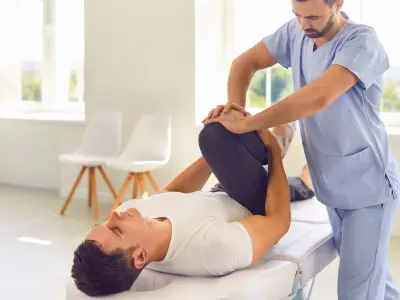 Physical therapy is one of the most effective ways to treat long-term pain. It is a type of treatment that helps in regaining normal movement and easing pain. Physical therapy is done in a combination of exercises and stretches. It helps manage neck and back pain, sports injuries, jaw problems, and hip, wrist, and knee pain [5].
Physical therapy is one of the most effective ways to treat long-term pain. It is a type of treatment that helps in regaining normal movement and easing pain. Physical therapy is done in a combination of exercises and stretches. It helps manage neck and back pain, sports injuries, jaw problems, and hip, wrist, and knee pain [5].
Massage Therapy
Deep tissue massage is a therapeutic technique primarily designed to address musculoskeletal issues like strains and sports injuries. It involves the application of sustained pressure through slow, deep strokes that target the inner layers of muscles and connective tissues. This approach not only helps break up scar tissue formed after an injury but also alleviates muscle tension.
Additionally, deep-tissue massage can enhance healing by increasing blood flow and reducing inflammation. Techniques such as acupressure, trigger point therapy, kneading, myofascial release, and rolling effectively release deep muscle knots and spasms [6].

Heat And Cold Therapy
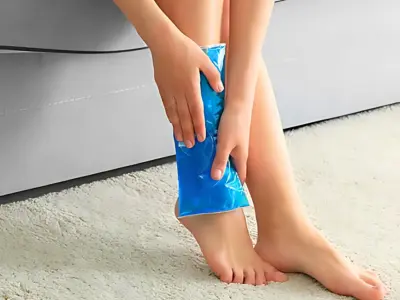 One of the effective ways to treat body pain is through using heat and cold compressants.
One of the effective ways to treat body pain is through using heat and cold compressants.Heat therapy enhances blood circulation to the targeted area, making it effective for alleviating muscle pain and stiffness. In contrast, cold therapy helps minimize inflammation and is particularly beneficial for treating acute injuries and pain [7].
Acupuncture
Acupuncture is a therapeutic technique that involves the insertion of very thin steel needles into specific points on the body, including the back, neck, head, and face. This practice aims to help treat various health conditions and symptoms, particularly pain. It is commonly used to address body pain arising from the following conditions-
- Arthritis
- Back, neck, and muscle pain
- Headaches and migraines
- Knee pain
- Menstrual cramps
- Sports injuries
- Facial pain and other nerve-related discomforts
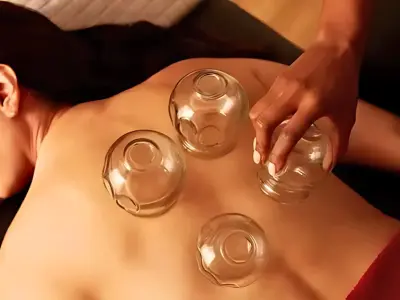
By targeting these areas, acupuncture can provide relief and support overall well-being [8].
When To Consult A Healthcare Provider
While taking muscle relaxers, make regular appointments with your doctor to assess their effectiveness and mitigate potential side effects.
Otherwise, one should consult a doctor in the following situations-
- For signs of adverse reactions
- Lack of improvement
- For long-term use considerations
- If you think you are developing a dependence on the medication.
Muscle Relaxers Options At Iyrin Health
FAQs
Are muscle relaxers addictive?
Do muscle relaxers help with pain?
Do muscle relaxers help with inflammation?
Are muscle relaxers a controlled substance?
Can you overdose on muscle relaxers?
How do muscle relaxers make you feel the next day?
Can you get addicted to muscle relaxers?
Are muscle relaxers bad for you?
Can muscle relaxers make pain worse?
Can you get muscle relaxers over the counter?
Does muscle relaxers help with nerve pain?
Do muscle relaxers make you tired?
Can you take muscle relaxers with alcohol?
Why is my muscle relaxer not working?
- First, the dosage may not be appropriate for your specific condition.
- Different muscle relaxers also vary in their effectiveness depending on the type of muscle pain or tension.
- Using the medication frequently can develop a tolerance, diminishing its effects.
- Underlying factors such as stress, lack of sleep, or not adhering to physical therapy recommendations
Why do muscle relaxers make you sleepy?
Do muscle relaxers make you feel loopy?
Is acetaminophen a muscle relaxer?
Is a muscle relaxer a narcotic?
Can you drive on muscle relaxers?
Can you give some skeletal muscle relaxants examples?
References
- Muscle Relaxers, clevelandclinic.
- Muscle relaxant, wikipedia.
- Side Effects and Risks of Muscle Relaxers, spine-health.
- Side Effects of Muscle Relaxers, americanaddictioncenters.
- What Is Physical Therapy, WebMD.
- Is a Deep Tissue Massage What Your Muscles Need, Healthline.
- Treating Pain with Heat and Cold, Healthline.
- Acupuncture, clevelandclinic.

 info@iyrinhealth.com
info@iyrinhealth.com